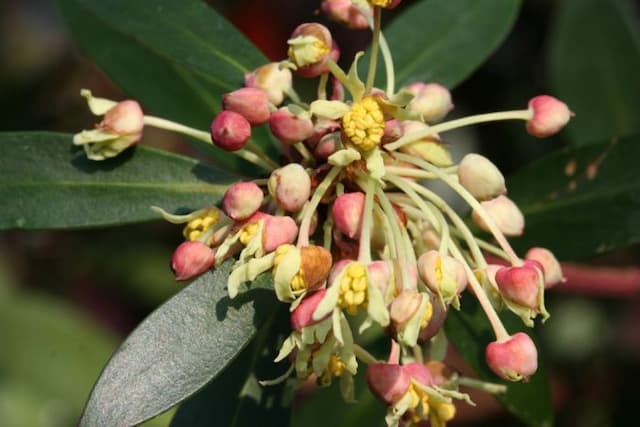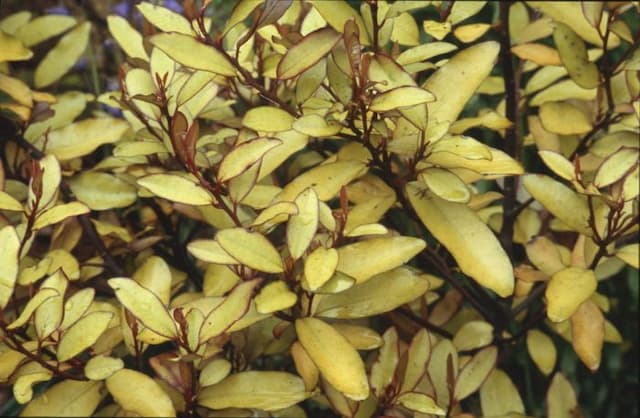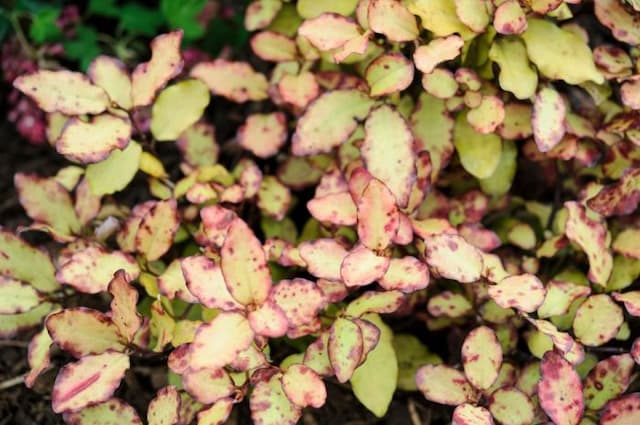Winter's Bark Drimys winteri

ABOUT
Drimys winteri, commonly known as winter's bark, is a plant that boasts leathery, glossy green leaves that feature a bold, pointed shape with a wave-like edge. Upon closer inspection, one can see conspicuous veins running through the foliage. The leaves grow in a whorled arrangement, radiating around the stem to create an attractive, spiraled pattern that adds to the plant's aesthetic. The winter's bark is also admired for its aromatic bark that exudes a warm, spicy scent when scraped. This bark is typically a rich brown color, peeling away in curls and revealing a new layer underneath with a smooth, somewhat shiny surface. One of the most striking features of the winter's bark is its flowers. These appear as clusters of delicate, small blossoms, usually in a striking white tone that contrasts beautifully with the dark green leaves. Each flower is composed of a multitude of stamens, which create a feathery, soft look, encircling a central ovary. Following the blooming period, the winter's bark produces fruits that start as a green hue and mature into a darker shade. These fruits are compact and contain seeds that are capable of germinating to propagate the species. Overall, the winter's bark is noted for its lush evergreen presence, offering both visual appeal and aromatic delight in settings where it is grown.
About this plant
 Names
NamesFamily
Winteraceae
Synonyms
Winter's Bark, Canelo, Winter's Cinnamon
Common names
Drimys chilensis, Drimys granadensis var. chilensis, Drimys granadensis var. mexicana, Wintera aromatica, Wintera chilensis, Wintera granadensis var. chilensis, Wintera granadensis var. mexicana, Wintera ovalifolia, Wintera winteri.
 Toxicity
ToxicityTo humans
Winter's bark, the common name for Drimys winteri, is not generally considered highly toxic to humans. However, large amounts of any non-food plant ingested could potentially cause adverse effects due to a variety of plant compounds, and some people may be more sensitive than others, leading to mild gastrointestinal upset or a skin reaction when handled. Ingesting parts of winter's bark in reasonable quantities is unlikely to result in severe poisoning for humans.
To pets
Winter's bark is not typically known for its toxicity to pets. As with humans, it does not have a widespread reputation for being highly poisonous to animals either. However, it is always advisable to prevent pets from eating plants that are not intended for consumption, as the various compounds in non-food plants like winter's bark could cause upset stomachs or other mild gastrointestinal symptoms if consumed in large enough quantities.
 Characteristics
CharacteristicsLife cycle
Perennials
Foliage type
Evergreen
Color of leaves
Green
Flower color
White
Height
15 feet (4.57 meters)
Spread
10 feet (3.05 meters)
Plant type
Tree
Hardiness zones
7
Native area
South America
Benefits
 General Benefits
General Benefits- Ornamental Value: Drimys winteri, commonly known as Winter's Bark, is an attractive evergreen tree or shrub, offering year-round visual interest for gardens and landscapes.
- Culinary Uses: The bark of Winter's Bark has historically been used as a spice and offers a peppery, aromatic flavor that can be utilized in cooking.
- Habitat for Wildlife: It provides a habitat and food source for various wildlife species, including birds and insects.
- Durable Wood: The wood of Winter's Bark is hard and durable, making it useful for tool handles and other items requiring strength.
- Aromatic Properties: The leaves and bark of the plant exude a spicy scent, which can be pleasing in the garden or when used in aromatic applications.
 Medical Properties
Medical Properties- Antimicrobial: Winter's bark has been traditionally used for its potential antimicrobial effects against various pathogens.
- Antifungal: Extracts from the plant have demonstrated antifungal activity in some studies.
- Anti-inflammatory: The plant is believed to have anti-inflammatory properties, potentially aiding in the reduction of inflammation.
- Anesthetic: There is evidence to suggest Winter's bark may have local anesthetic effects.
- Antipyretic: Historically, the bark of the Winter's bark has been used to reduce fever.
- Antioxidant: The plant contains compounds that are thought to have antioxidant properties.
 Air-purifying Qualities
Air-purifying QualitiesThis plant is not specifically known for air purifying qualities.
 Other Uses
Other Uses- The wood of Winter's Bark can be used in fine woodworking for decorative items, thanks to its even grain and appealing color.
- Essential oils extracted from Winter's Bark are utilized in perfumery, giving a spicy and fresh scent profile to various fragrances.
- In the leather industry, the bark of Winter's Bark might be used in the tanning process due to the presence of tannins.
- Dried and powdered Winter's Bark could be used as a natural dye to impart color to fabrics, wool, or even handicrafts.
- The bark and leaves of Winter's Bark may be steeped to create a flavored, aromatic water for culinary use in recipes that call for a spicy note.
- Winter's Bark has been traditionally used to flavor a spirit called "pisco," which is a popular alcoholic beverage in South America.
- The bark of Winter's Bark can serve as an insect repellent when burnt, releasing a scent that is unappealing to many pests.
- Wood from Winter's Bark might be suitable for the construction of small wooden boats or canoes, given its resistance to rot and water.
- Winter's Bark could be incorporated into landscape gardening as an ornamental plant, thanks to its attractive flowers and foliage.
- Hobbyists may use the bark of Winter's Bark to create unique pieces of jewelry, employing its textural and visual qualities.
Interesting Facts
 Feng Shui
Feng ShuiThe Winter's Bark is not used in Feng Shui practice.
 Zodiac Sign Compitability
Zodiac Sign CompitabilityThe Winter's Bark is not used in astrology practice.
 Plant Symbolism
Plant Symbolism- Protection: Drimys winteri, commonly known as Winter's Bark, has bark containing aromatic compounds historically believed to protect against diseases, which symbolizes protection and safety.
- Healing: The bark was utilized to prevent scurvy due to its high vitamin C content, symbolizing the plant's healing and medicinal properties.
- Resilience: Being native to the Magellanic and Valdivian temperate rainforests, where harsh conditions prevail, Winter's Bark represents the ability to withstand tough environments and circumstances.
- Endurance: Its capacity to endure cold climates reflects qualities of endurance and perseverance.
 Water
WaterThe Winter's Bark should be watered thoroughly, allowing the top inch of soil to dry out between waterings. This typically means watering once every week or two, depending on the humidity and temperature, but less often in winter. Provide 1 to 2 gallons of water to moisten the soil deeply, promoting strong root growth. Over-watering can lead to root rot, so it's important to ensure good drainage and not let the plant sit in water.
 Light
LightWinter's Bark thrives in full sun to partial shade. It prefers a spot that offers bright, indirect light for most of the day. Protect it from harsh, direct afternoon sun, especially in hotter climates, to prevent leaf scorch. An eastern or western exposure with dappled light is ideal.
 Temperature
TemperatureWinter's Bark is hardy and can tolerate a temperature range from 20 to 80 degrees Fahrenheit, but it performs best between 60 and 75 degrees Fahrenheit. Avoid exposing the plant to temperatures below 20 degrees Fahrenheit for prolonged periods as it can severely damage the plant.
 Pruning
PruningPrune Winter's Bark to maintain its shape and remove any dead or damaged branches. The best time for pruning is in late winter or early spring before new growth starts. Pruning can be done annually, but it's not necessary to prune every year unless shaping is needed or to remove unhealthy parts.
 Cleaning
CleaningAs needed
 Soil
SoilWinter's Bark prefers well-draining, acidic to neutral soil with a pH of around 5.5 to 7. A mix of peat, perlite, and pine bark suits it well, providing aeration and proper drainage.
 Repotting
RepottingWinter's Bark should generally be repotted every 2-3 years, or when the plant has outgrown its current container to encourage continued growth and ensure soil vitality.
 Humidity & Misting
Humidity & MistingWinter's Bark thrives in moderate to high humidity levels, ideally around 50-60%, which supports its lush foliage and healthy growth.
 Suitable locations
Suitable locationsIndoor
Keep Winter's Bark in bright, indirect light and maintain high humidity.
Outdoor
Plant in partial shade, sheltered from wind, in moist soil.
Hardiness zone
7-9 USDA
 Life cycle
Life cycleWinter's Bark (Drimys winteri) begins its life cycle as a seed, usually dispersed by wind or animals. After seed germination, a seedling emerges and establishes a root system. As it matures, the plant develops a woody stem and foliage, entering the vegetative stage where it grows leaves and branches. Once it reaches maturity, Winter's Bark enters the reproductive phase, characterized by the production of flowers that are pollinated by insects. Following successful pollination, the flowers develop into berries that contain seeds, completing the cycle. The plant may live for many years, going through multiple reproductive cycles within its lifetime.
 Propogation
PropogationPropogation time
Spring-Early Summer
Winter's Bark, or Drimys winteri, is commonly propagated by seed or semi-hardwood cuttings. The most popular method involves taking semi-hardwood cuttings, which is typically done in late summer. To propagate by this method, a gardener would select a healthy, semi-ripe piece of stem from the current year's growth. The cutting, which should be about 4-6 inches (10-15 cm) long, is made just below a leaf node and should include at least two or three sets of leaves at the top. The bottom set of leaves is removed, and the cut end is dipped in rooting hormone to encourage root development. It is then inserted into a well-draining soil mix and kept under high humidity and indirect light until rooting occurs, which can take several weeks. Regular misting and ensuring the soil remains moist but not waterlogged are crucial to successful root development in Winter's Bark cuttings.




